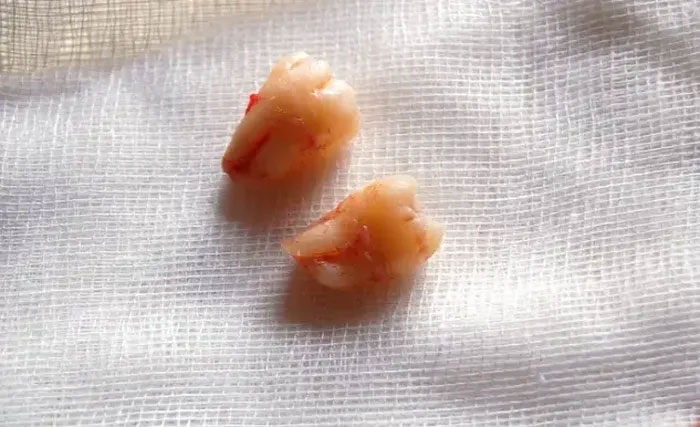When we were in school, learning about evolution felt outdated and slow. But evolution is still happening, and it is occurring with us.
Right here, right now.
It’s too early to say what humans will look like in a few thousand years, but we can gather some of the most recent quirks—and even superpowers—happening to humans thanks to the power of selection.
1. Adults Drinking Milk
Drinking milk is one of the hallmark traits of mammals, but humans are the only species on Earth that can digest milk after infancy, although currently, more than 75% of the world’s population still lacks lactose tolerance.

Humans are the only species on Earth that can digest milk after infancy.
After weaning, all other mammals, and most humans, stop producing lactase, the enzyme necessary to break down lactose, the sugar in milk.
However, a mutation that occurred on the plains of Hungary about 7,500 years ago allowed some people to digest milk in adulthood. We may have started consuming cheese—cheddar and feta contain less lactose than fresh milk, and softer cheeses like Parmesan have almost no lactose.
This may seem nutritionally unreasonable (though quite delicious), but the ability to digest calorie-rich dairy products was immensely beneficial for humans needing to survive the harsh winters of Europe.
2. Disease Resistance
Evolution is about the survival of the fittest—and an important part of evolutionary fitness is not dying from disease before reproducing. It makes sense that evolution would help us bolster our defenses against some common diseases.
The most studied disease we have recently overcome is malaria. If you’ve studied introductory biology, you might remember the strange connection to sickle cell anemia. This is because there is a specific gene that, if you have one copy, will protect red blood cells from malaria parasites invading them—but two copies will distort the red blood cells and block their passage through blood vessels.
But that’s not the only trick developed in response to malaria. There are also over a hundred different genes that cause a deficiency in a protein related to breaking down red blood cells. This makes it harder for malaria parasites to invade red blood cells. Another recent mutation prevents malaria parasites from attaching to the placenta.
And it’s not just malaria—evolution has helped spread adaptive measures protecting against leprosy, tuberculosis, and cholera in certain populations. Some scientists have suggested that living in cities may aid this process.
3. Blue Eyes
Blue eyes are another trait that has developed recently, and scientists have traced it back to a mutation in a single ancestor 6,000 to 10,000 years ago.
The mutation affects the OCA2 gene, which encodes the protein necessary for melanin production, giving color to our skin, hair, and eyes. This essentially “turned off” the ability to have brown eyes by limiting the melanin produced in the iris, “diluting” eye color from brown to blue.
Having lighter eyes does not provide a specific survival advantage for anyone, but because the blue eye gene operates similarly to a recessive trait (though a bit more complex), blue-eyed fathers may be more certain that their children are indeed their own.
4. Breathing at High Altitudes

Tibetans have a genetic tendency to produce more oxygen-carrying hemoglobin.
The Tibetans live in one of the most inhospitable places: the Himalayas. Their ability to handle low oxygen levels up there is not due to mere hardiness—it is encoded in their genes.
A study compared native Tibetans living at altitudes over 3,000 meters in the Himalayan plateau with Han Chinese from Beijing, who are genetically closely related but live at sea level.
Researchers found that the blood of Tibetans has a genetic tendency to produce more oxygen-carrying hemoglobin. When this mutation occurred is still debated, but some geneticists estimate it happened at least 3,000 years ago (although archaeologists are likely to push that date back much further).
5. Wisdom Teeth Loss
It’s not just oral surgeons who remove wisdom teeth (the third molars) from human mouths—evolution has played a significant role as well.
On the evolutionary path to becoming human, our larger brains have cramped our skulls and narrowed our jaws, making it difficult for the third molars to emerge from the gums.
And after we began cooking and developing agriculture thousands of years ago, our diets became softer. The shift to soft grains and starches requires less chewing than the previous hunter-gatherer diet. This means the jaw does not develop as robustly as before, keeping wisdom teeth trapped beneath the gums, increasing the risk of painful and potentially deadly infections.

Keeping wisdom teeth trapped beneath the gums increases the risk of painful and deadly infections.
Several thousand years ago, a mutation occurred that prevented wisdom teeth from growing. Now, one in four people is missing at least one wisdom tooth. Those most likely to be missing at least one wisdom tooth are the Inuit in the far northern regions of Greenland, Canada, and Alaska.
6. Blushing When Drinking Alcohol
The alcohol flush reaction is not just a fact; it is also a recently developed trait that may protect East Asians from deadly cancer.
About 36% of East Asians (from China, Japan, and Korea) experience flushing and nausea when drinking alcohol. This is due to a deficiency in an enzyme called ALDH2.
While this may pose some social challenges in contexts with heavier-drinking peers, it is a significant indicator of serious health risks. Those with ALDH2 deficiency are also at a higher risk of developing esophageal cancer from alcohol consumption.
Strangely, scientists believe this mutation occurred after the advent of agriculture and distillation.
7. Shrinking Brain
We hold our brains in high regard, but it turns out they have been shrinking for over 20,000 years. The change in adult males is estimated to be the size of a tennis ball. However, scientists do not believe this means we are becoming less intelligent.
One hypothesis suggests that each of us relies more on social structures to help us navigate life’s obstacles, so we do not need as much brain space as our ancestors. As we domesticated animals like dogs and cats, their brains also shrank. Some scientists argue that smaller brains may actually indicate gentler, more peaceful species.

















































